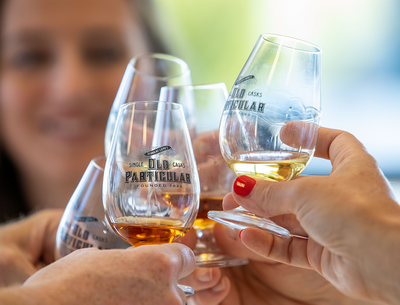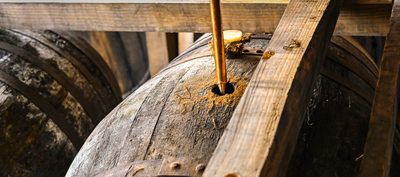Our Fellow, Dr Heinz Weinberger from Whisky-Connaisseur, delves a bit into the history of Blended Scotch Whisky and asks, whether blending is an art, science and/or trial and error…
About nine out of ten bottles of Scotch Whisky sold worldwide are blends, which are made up of different Malt and Grain Whiskies. Blended Scotch Whisky is the beating heart of the Scotch Whisky industry. They are a combination of a variety of components to form a harmonious and unified whole. But how are blends made and new ones created? That's not so easy, because understanding how Malt and Grain Whiskies work together in a blend requires a great deal of skill, experience and time.
A look back in history shows that it was an Irish taxman who helped Scotch Whisky to world fame. In 1830, Aeneas Coffey applied for a patent for the continuous distillation of Grain Whisky. A process that had previously been developed by the Frenchman Jean-Baptiste Cellier-Blumenthal and improved by the Scot Robert Stein in the 1920s, but was technically refined and made more efficient by Coffey. With such a continuously operating distillation plant, known under the terms Column, Coffey or Patent Still, distillates with a content of almost 95 percent abv can be achieved. Grain Whiskies produced in this way are made from wheat or corn, to which a small proportion of Malted barley is added (mostly between 5 and 15 percent) as a natural enzyme source. Compared with the batchwise working copper pot stills, alcohol could be produced in much higher quantities and also much more economically for the first time.
It is safe to assume that in those days, wine and spirit merchants mixed these richer, stronger, rougher, and often quite variable quality Malt Whiskies with the lighter Grain Whiskies to create a spirit with a more pleasant taste and wider acceptance by the public. This seems logical, as many of these traders were already very familiar with blending teas or wines. Grain Whisky thus extended the appeal of Scotch Whisky to a much wider market. The first well-known branded blend appeared in 1853, created by Edinburgh merchant Andrew Usher: Usher's Old Vatted Glenlivet. Few years later, the Gladstone's Spirits Act of 1860 allowed Malt and Grain Whiskies to be blended under bond and sold as Whisky. This made it possible to create Scotch blended Whisky with reproducible taste and style. Unexpected support for the success of Scotch blended Whisky was provided by a tiny insect: phylloxera vastetrix. Introduced from America, it devastated the European vineyards in the most massive way in the second half of the 19th century and deprived brandy and cognac, which had been popular until then with the English bourgeoisie. This cleared the way for Scotch Whisky, which was able to fill this gap.
Historians call the 1890s the era of the Scotch Whisky boom. From then on, the fortunes of Malt Whisky producers were inextricably linked to those of blender companies. The leading blending houses showed great interest in the Malt distilleries as they bought them or built new ones to secure the supply of their blends. Among the five great blenders who made a fortune during the Whisky boom were James Buchanan, Tommy Dewar, John Haig, Peter Mackie and John Walker. These ‘big five’ revolutionised the Whisky business with a mixture of imagination, passion, commitment and perseverance and created brands that are still known around the world today.

To produce a Blended Scotch, Single Malt Whiskies and Single Grain Whiskies from Scottish distilleries are married or blended together. Each of these distilleries produces a unique spirit that is different from the others. The Master Blender is responsible for exploiting these different taste profiles and characteristics and combining them into a balanced and rounded blend that always has a consistent sensory profile from batch to batch. But how does he/she do his/her work today? Is blending an art or science? Well, both of these are certainly true. For many blenders their work is a combination of analytical and critical thinking, experience and artistic intuition. Others rather follow their heart and are driven by passion. The blending procedure varies from company to company, but usually follows a similar pattern. Some first mix the Grain Whiskies together and then add the Malts. Others do it the other way round – just like Douglas Laing. For the family business, the Malt Whisky is the soul of the blend and so the different Single Malts are put together first. For Douglas Laing's founding brand, King of Scots Blended Scotch Whisky, first created in 1886, Chairman and Master Blender Fred Laing selects and marries the Single Malt and Single Grain casks all by hand.
The Master Blenders divide the Malt Whiskies contained in their blends into three categories. The basis is the so-called ‘core Malts’ which define the overall character of the finished blends. The most important group are the ‘flavouring Malts’ or ‘top dressings’. These are high quality Whiskies with special aromatic properties that give the blend its most important taste notes and depth. The last group are the ‘packers’ used as fillers, which are usually not very intense in aroma and make up about half of the Malts used. Then, of course, there are the Grain Whiskies, which also come from various distilleries. At the moment there are seven Grain distilleries active in Scotland, namely Cameronbridge, Girvan, Invergordon, Loch Lomond, North British, Starlaw and Strathclyde. Before bottling, demineralised water is used to reduce the alcohol content to drinking strength, usually 40 or 43 percent by volume, and the mixture is in most cases chill-filtered as well as coloured.

The classic blending process combines about 15 to 50 different Malt Whiskies with two to five Grain Whiskies, with the final blend usually containing more Grains than Malts. However, there are no strict rules on relative percentages. Typically, the composition of a standard blend will have a ratio of 70 to 80 percent Grain Whiskies and 20 to 30 percent Malts. For premium blends and those with an age statement, the Malt Whisky proportion is correspondingly higher at around 40 percent. For example, the 12 Years Old Syndicate Blend 58/6, also part of the Douglas Laing portfolio, includes 18 different Single Malts and four Single Grains. The blend is matured in a Solera system, which ensures its quality and consistency. Finally, the blend further matures for up to two years in Spanish Oloroso sherry casks. This final marriage and maturation process give the Syndicate Blend 58/6 its exceptionally smooth and distinctive taste.
FOR MANY BLENDERS THEIR WORK IS A COMBINATION OF ANALYTICAL AND CRITICAL THINKING, EXPERIENCE AND ARTISTIC INTUITION. OTHERS RATHER FOLLOW THEIR HEART AND ARE DRIVEN BY PASSION.
Once a Blended Scotch is established, even more skill is required to ensure the continuity of its character. For this, many variables have to be taken into account. Each Whisky in the blend was selected for its specific taste profile. The Master Blender, however, is confronted with Malt and Grain Whiskies of ever-changing quality. Therefore, a possible adjustment of the blend formula is necessary. There is also a risk that one or more Malt or Grain Whiskies may no longer be available, for example due to the closure of a particular distillery. For this, suitable alternatives must be selected or the formula adjusted accordingly. Years of experience and detailed knowledge of distilleries are essential skills of the Master Blender.
The production of a blend is in a certain way still a ‘trial and error’ process, too. But the more experience the Master Blender has, the more concentrated he/she can follow the path and build on the knowledge of what works best. Failures can happen, but they also bring new insights. One always learns something new.





